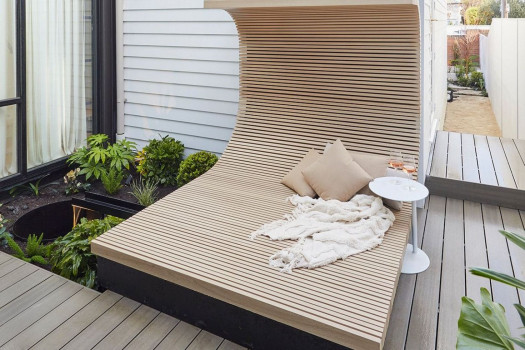Bathroom Lighting Upgrades: From Basic to Beautiful




Bathroom lighting is pivotal in shaping the ambiance and functionality of any space, and the bathroom is no exception. Whether starting your day with a morning routine, unwinding in a relaxing bath, or preparing for an evening out, the right lighting can transform the experience.
Upgrading bathroom lighting not only enhances the room's aesthetic appeal but also its practical usability.
Our expert product specifiers, featured on Archify—a comprehensive platform that enables product suppliers to showcase their offerings, gain visibility, and be specified by design professionals—collectively agree on the meticulous attention to detail that elevates bathroom lighting from basic to beautiful.
Here are some expert tips to help you achieve the perfect lighting setup in your bathroom.
1. Assess the Current Lighting Situation
Before making any changes, evaluate the current lighting. Identify areas that are too dim or too bright and consider how the lighting affects the overall atmosphere.
Only by assessing your current situation can you truly understand the state of your current lighting. This process will help you recognise the dire or outdated conditions compared to the innovative solutions offered by Archify. By thoroughly evaluating your lighting, you'll clearly see the transformative benefits that modern, efficient Archify products can bring to your space.
Step 1: Evaluate Current Lighting
Assess Overall Lighting: Walk through the entire space to observe the existing lighting. Identify areas that are too dim or too bright, noting how these extremes affect the overall atmosphere and functionality of each space.
Identify Problem Areas: Mark specific spots where lighting is insufficient or overly intense. Pay special attention to key functional areas such as workspaces, reading nooks, and seating areas.
Types of Fixtures: Catalog the types of fixtures currently in use (e.g., ceiling lights, wall sconces, floor lamps, table lamps) and their placements. Note the style, size and general condition of each fixture.
Quality of Light: Evaluate the quality of light produced by each fixture. Consider aspects such as color temperature (warm vs. cool light), brightness (measured in lumens), and the distribution of light (focused vs. diffuse).
Natural Light Assessment: Take note of natural light sources, such as windows and skylights. Observe how natural light interacts with artificial lighting throughout the day.
Step 2: Gather Feedback
User Experience: Collect feedback from individuals who use the space regularly. Ask about their lighting preferences and any issues they face with current lighting (e.g., glare, shadows, eye strain).
Functionality Needs: Understand the specific lighting needs for different activities conducted in the space (e.g., reading, cooking, working, relaxing).
Aesthetic Preferences: Gather input on the desired atmosphere and aesthetic goals for the space. Consider how lighting can enhance or detract from these objectives.
Step 3: Research and Plan Improvements
Lighting Options: Research various lighting options that can address the identified issues and meet the space’s needs. Look into different types of bulbs, fixtures, and smart lighting solutions.
Design Trends: Stay updated on current lighting design trends and technologies. Consider incorporating energy-efficient options, such as LED bulbs, and smart lighting systems that allow for customization and automation.
Budget and Timeline: Develop a budget for the lighting improvements. Factor in the cost of new fixtures, bulbs, and potential electrical work. Create a timeline for implementation, prioritising critical areas first.
Step 4: Implement Changes
Replace Fixtures: Begin by replacing outdated or inefficient fixtures with new, energy-efficient models that provide better quality light.
Adjust Placement: Reposition existing fixtures or add new ones to ensure even lighting distribution and eliminate dark spots.
Fine-tune Lighting: Adjust the brightness and color temperature of lights to create the desired atmosphere. Consider using dimmer switches and smart lighting controls for flexibility.
Step 5: Final Review and Adjustments
Post-Implementation Evaluation: After making the changes, reevaluate the lighting to ensure it meets the desired objectives. Check for improvements in functionality, atmosphere, and aesthetics.
Gather Feedback Again: Seek feedback from regular users to confirm that the new lighting addresses their needs and preference.
Make Necessary Adjustments: Make any final tweaks or adjustments based on feedback and observation to perfect the lighting setup.
2. Layer the Lighting

Effective bathroom lighting involves layering different types of light to create a balanced and versatile space. There are three main types of lighting to consider:
Ambient Lighting: This is the general lighting that illuminates the entire bathroom. It often comes from ceiling-mounted fixtures or recessed lights. For an even spread of light, consider adding a central fixture or multiple recessed lights.
Task Lighting: This lighting is focused on specific areas where tasks are performed, such as around the vanity or mirror. Wall-mounted sconces on either side of the mirror or an LED light strip above it can provide shadow-free illumination for activities like shaving, makeup application, and grooming.
Accent Lighting: Accent lighting adds depth and dimension to the bathroom, highlighting architectural features or decor. Consider installing LED strips under cabinets, around the bathtub, or in niches to create a spa-like ambiance.
3. Choose the Right Fixtures
Selecting the right fixtures is key to achieving the desired lighting effect. Here are some popular options:
Vanity Lights: Wall sconces or fixtures mounted above the mirror are essential for task lighting. Ensure they provide even illumination and are positioned at eye level to minimize shadows.
Ceiling Lights: Flush mounts, semi-flush mounts, or chandeliers can serve as ambient lighting sources. Choose a style that complements the bathroom's decor.
Recessed Lights: These are great for providing general lighting without taking up visual space. Place them strategically to avoid casting shadows on the face when using the mirror.
Pendant Lights: Hanging pendant lights can add a touch of elegance and provide focused lighting for specific areas.
Opt for Energy-Efficient Solutions: Upgrading to energy-efficient lighting not only reduces the carbon footprint but also lowers energy bills. LED lights are a popular choice for bathroom lighting due to their long lifespan, low heat emission, and energy efficiency. Look for fixtures with built-in LED technology or choose LED bulbs for existing fixtures.
5. Consider Dimmers and Smart Lighting
Installing dimmer switches allows adjustment of light intensity according to needs and mood. This is particularly useful for creating a relaxing atmosphere during a bath or a bright, invigorating environment in the morning.
Smart lighting systems offer even more flexibility and control. With smart bulbs or fixtures, it is possible to adjust the brightness and color temperature using a smartphone app or voice commands. Some systems also allow schedules and custom lighting scenes to be set.
6. Pay Attention to Colour Temperature

The color temperature of the lighting affects the ambiance of the bathroom. Measured in Kelvin (K), it ranges from warm (yellowish) to cool (bluish) tones.
For bathroom lighting, a color temperature between 3000K and 4000K is ideal, as it provides a balance between warmth and brightness. Warm white (around 3000K) is perfect for creating a cozy, inviting atmosphere, while cool white (around 4000K) is great for task-oriented areas.
7. Ensure Proper Placement and Installation
Proper placement and installation of fixtures are essential for achieving the desired lighting effect. Follow these guidelines:
Vanity Lights: Position wall sconces at least 36-40 inches apart on either side of the mirror, with the center of each fixture about 66 inches above the floor. If using an overhead fixture, place it about 75-80 inches above the floor.
Ceiling Lights: Distribute recessed lights evenly across the ceiling to avoid dark spots. Ensure they are not directly above the mirror to prevent harsh shadows.
Accent Lights: Highlight architectural features, artwork, or other focal points with adjustable fixtures to direct the light precisely where needed.
8. Don’t Forget About Safety
Safety is paramount when dealing with bathroom lighting due to the presence of water and humidity. Ensure all fixtures and bulbs are rated for damp or wet locations. Use ground fault circuit interrupters (GFCIs) for outlets near water sources to prevent electrical hazards.
Upgrading bathroom lighting can transform the space into a functional and aesthetically pleasing retreat. By assessing the current setup, layering the lighting, choosing the right fixtures, and considering energy-efficient and smart solutions, it is possible to create a well-lit, inviting bathroom that meets all needs.
Pay attention to color temperature, proper placement, and safety to ensure a successful lighting upgrade that enhances the daily routine and adds value to the home.




 Indonesia
Indonesia
 New Zealand
New Zealand
 Philippines
Philippines
 Hongkong
Hongkong
 Singapore
Singapore
 Malaysia
Malaysia


.jpg)





